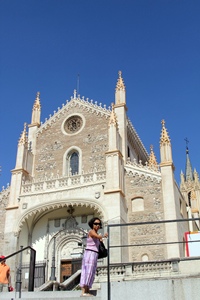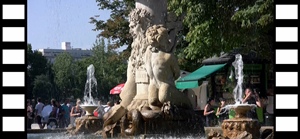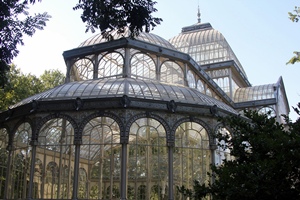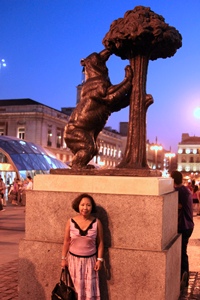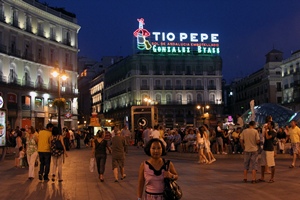We enjoyed it too, as it was a pleasant escape from some of the July heat. But we had to climb the hill (via a stairway) to get there. In so doing, we passed the San Jerónimo el Real church, a much-altered remnant of the original monastery.
We entered the park through one of the several gates (entry is free) and walked around looking at plants, statues and fountains.
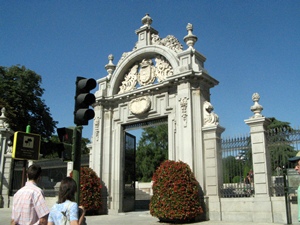
Puerta de Felipe IV Med Lrg |
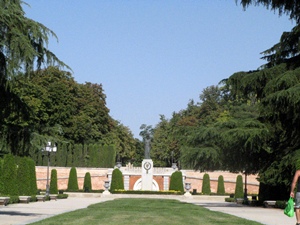
Paseo Parterre Med Lrg |
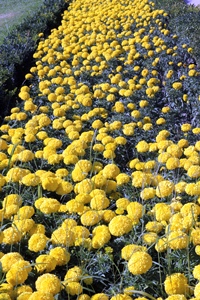
Flowers, Paseo Parterre Med Lrg Xlg |
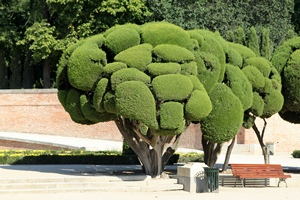
Weird Tree Things, Paseo Parterre Med Lrg Xlg |
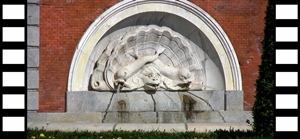
Fish Fountain, Nella on Ramp MP4-Sml MP4-Med WMV-HD |
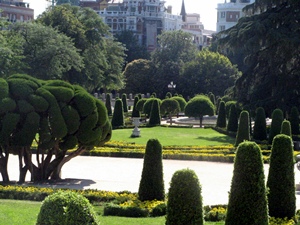
Gardens from Stairway Med Lrg |
After awhile we came across the Palacio de Cristal, a largely empty glass-and-iron structure that was built in 1887 to house plants and animals native to the Philippines, as part of an exhibition celebrating the islands. A large pond was also built in front of the Palacio, with a fountain and a small waterfall you can walk under.
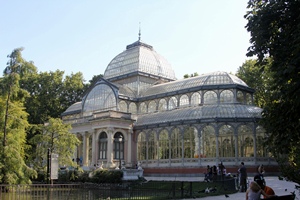
Palacio de Cristal Med Lrg Xlg |
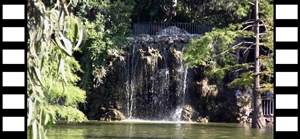
Palace, Pond and Waterfall MP4-Sml MP4-Med WMV-HD |
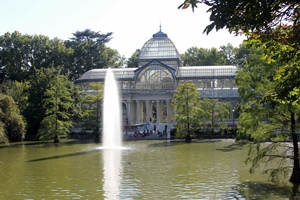
Fountain and Palace Med Lrg Xlg |
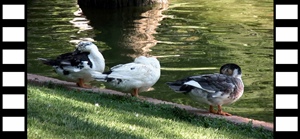
Ducks MP4-Sml MP4-Med WMV-HD |
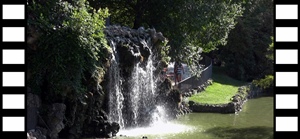
Nella and Waterfall MP4-Sml MP4-Med WMV-HD |
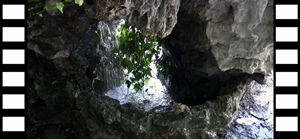
Under the Waterfall MP4-Sml MP4-Med WMV-HD |
When we entered the building itself, we found it to be not quite empty, being inhabited by a single tower built from laundry baskets, clothes hampers and other plastic containers of types to be found in the housewares department at Target. Noting the profound uselessness and equally profound silliness of the structure, we deduced that it must be a work of art, so we took pictures of it.
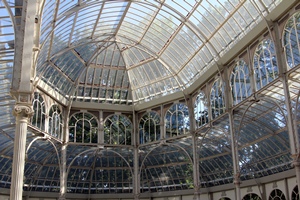
Interior, Palacio de Cristal Med Lrg Xlg |
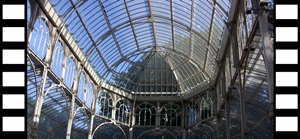
Interior, Palacio de Cristal MP4-Sml MP4-Med WMV-HD |
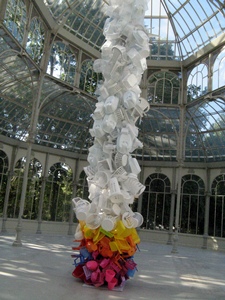
Tower of Plastic Med Lrg |
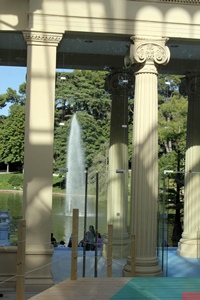
Fountain from Palace Med Lrg Xlg |
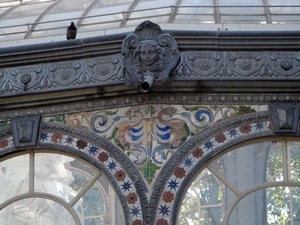
Palacio de Cristal Med Lrg |
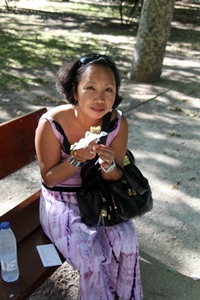
Nella with Ice Cream Med Lrg Xlg |
From the Palacio we walked over to the lake, which we found to be blanketed by a flotilla of small, identical rowboats. Evidently you can rent them and stage mock naval battles of your own. But everyone seemed to be acting pretty civilized (or as civilized as possible, with so many boats so close together), so there are no doubt rules as to behavior.
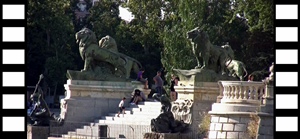
Lake, Boats and Stone Lions MP4-Sml MP4-Med WMV-HD |
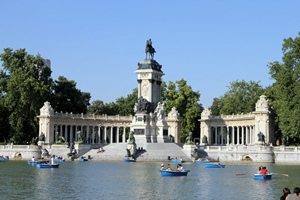
Lake and Monument to Alfonso XII Med Lrg Xlg |
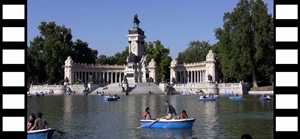
Monument and Boats MP4-Sml MP4-Med WMV-HD |
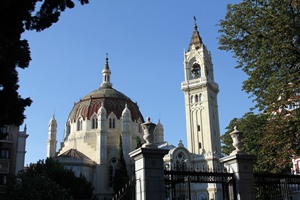
Iglesia de San Manuel y San Benito Med Lrg Xlg |
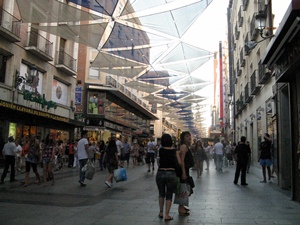
Calle del Carmen Med Lrg |
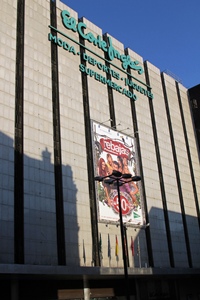
El Corte Inglés Med Lrg Xlg |
The plaza called Puerta del Sol seems to be the center of nightlife in Madrid, and it can get crowded. A number of iconic landmarks can be found here. There’s a statue of a mounted Carlos III, and another statue of a bear and a strawberry tree, the heraldic symbol of the city (yes, I know, strawberries don’t grow on trees – it’s actually a madroño tree; stop making trouble).
But the most immediately recognizable landmark is the neon Tio Pepe sign presiding over the square (Tio Pepe is a brand of sherry made in Andalusia), and all visitors must have their pictures taken with it. But advertising notwithstanding, drinking has apparently been outlawed in Madrid in public areas such as the Puerta del Sol (not sure what the penalty is – it’s probably best not to find out). But while the plaza may no longer be as raucous as formerly, the Puerta del Sol and its surrounding streets remain the place to be of a summer evening.
We didn’t stay long, heading back toward our hotel. On the way we paused for some pictures of a street called Gran Vía, which looked photogenic. Gran Vía is a major street, but the area north of the street is apparently a place to be avoided, especially at night. We did just that, heading back to the hotel to rest up for our morning expedition to the Palacio Real.
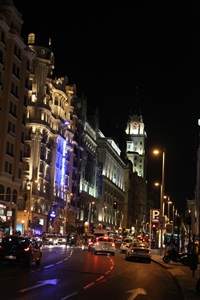
Gran Vía Med Lrg Xlg |
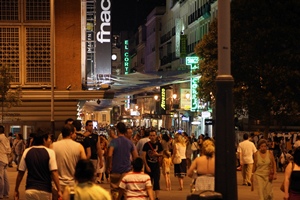
Calle de Preciados Med Lrg Xlg |
